Section 2
Transcriber-Generated Pages and Front Matter
2.1 Fundamentals
2.2 Transcriber-Generated Page Basics
2.3 Title Pages
2.4 Second and Subsequent Title Pages
2.9 Dedications and Acknowledgements
2.10 Table of Contents
2.11 Other Front Matter
2.12 Body Matter
2.13 Samples
2.1 Fundamentals
Front matter and body matter are terms that align with publisher source files, and these files are used frequently in braille production. All front matter is transcribed in the same order as print.
2.2 Transcriber-Generated Page Basics
Title page
Second title page(s)
Special Symbols page
Transcriber's Notes page
a. These pages do not have print page numbers.
b. Braille page numbers are preceded by the letter t, e.g., t1, t2, etc.
c. Several titles of a series may be bound together by the publisher, with individual title pages, ISBNs, etc. A title page, and a second title page if necessary, is inserted before the beginning of each title. Each new title page begins with braille page t1.
2.3 Title Pages
a. All volumes include a transcriber-generated title page with five segments of information. Information is grouped into the following order:
Title segment
Author segment
Publisher and Copyright segment
Transcriber/Transcription segment
Volume Information segment
b. The first title page must include text on the first and last lines of the braille page.
c. Use 1-3 format for all items on the title page unless an agency requires a different format.
d. There are no blank lines within a segment.
e. One or more blank lines may be inserted between segments, depending on the amount of information on the title page. Distribute the blank lines evenly when possible.
f. An agency may have its own requirements for title pages.
a. Place the book title, subtitle, series name, and the edition name or number, on the first line or lines of the title page.
b. Follow print for capitalization of all titles, subtitles, and grade levels.
c. Space permitting, each element of the title, subtitle, series name, and edition statement begins on a new line.
d. Some title pages are very dense with text, and there may not be enough space for each item to begin on a new line. The series name and edition may be placed on the same line as the title and grade level or subtitle, separated by semicolons.
e. A series name may be part of the title. Examine the text to determine what the correct title is. Check the list of the author's works and other places in the book where the title may be used. (See Sample 2-1: Title with a Series Name on page 2-24.)
f. A book may have a group of separate ancillary books as part of the set. The primary book title is used as the subtitle for the secondary books when the transcriber has the main text and the ancillary books. (See Sample 2-2: Titles in a Set on page 2-25.)
g. Grade/Level. A grade level shown in words or numerals is transcribed as printed and placed on the line with or following the book title. If there is room, the grade level goes on the same line as the title, separated by a semicolon. Sometimes this information is found only on the book spine or back cover. Do not include the grade level if it is not clearly apparent. A graphic design of lines, dots, etc., determined to be the grade level is transcribed as an arabic number. (See Sample 2-3: Grade Level on Back Cover on page 2-26 and Sample 2-4: Grade Level Indicated by Dots on Spine on page 2-27.)
h. The publisher's name is included in the full title when it appears with the title of the book. Publishers have stated that the publisher's name is a part of the title in this situation. Typically the publisher's name included as part of the title is important, because the publisher is an imprint of a larger publishing company. For example, Prentice Hall is a Pearson Education subsidiary. While the book may be published by Pearson Education, the title is a Prentice Hall book and consequently Prentice Hall is part of the title. (See
Sample 2-5: Title and Subtitle Including Publisher's Name
on page 2-28 and
Sample
2-6: Title with Edition Number and Subtitle
on page
2-29.)
a. Do not insert "By" before author/editor names unless it is included in print.
b. Follow print for capitalization of the author/editor names.
c. Authors may be listed on separate lines, or follow one another on the same line, separated by a comma.
d. Author affiliations/degrees are included on the title page if the information fits in its entirety.
e. Only the first or principal author or editor is placed on the title page when there are more than three names, or when all the names will not fit. Use "et al." following the first name. "Et al." is not italicized and the grade 1 indicator precedes al. Place the full list of authors/editors on the second title page. (See Formats, §2.4.2, Second and Subsequent Title Pages.)
Example 2-1: Title Page

,john ,gillespie1 et ;al4
f. The editor's name is used only when authors are not listed.
g. A translator's name is included on the line following the author's name. (See Sample 2-7: Translator on page 2-30.)
h. Names and information about the print illustrators are not included.
a. Publisher Information. Depending upon whether or not copyright clearance has been obtained through an agency, the title page includes one of the following:
(1) When authorized by copyright law, the title page states "Published by" followed by the publisher information.
Example 2-2: Publishing Statement for Authorized User
,publi%$ by ,/&>d ,press
,new ,york1 ,new ,york
(2) When permission has been specifically obtained from the publisher, the title page states "With permission of the publisher" followed by the publisher information.
Example 2-3: Publishing Statement for Permission Obtained
![]()
,)p]mis.n ( ! publi%]1 ,/&>d ,press
,new ,york1 ,new ,york
b. Publisher's City and State/Province. Many books list a group of publishing cities, and sometimes a state/province. Include the first city on the title page. The state/province is included only if one appears in print. Follow print if the state/province is spelled out or if the postal code (state/province abbreviation) is used.
c. Publisher's Website. The publisher's URL is included on the title page if it appears on the title page, copyright page, or cover of the book. Insert the website on the line after the publisher's city/state. (See Sample 2-8: Publisher Website on page 2-31.)
d. Copyright Notices
(1) Use the copyright symbol when it appears in print. Follow print for spacing.
(2) Only the most recent copyright date and copyright holder are placed on the title page of each volume. All other dates are ignored.
Example 2-4: Copyright Year
,copy"r ^c #bjje by ⠀⠀,macmillan_/,mc,graw-,hill
(3) When a text is copyrighted without a date, only the word "copyright," or the copyright symbol, is placed on the title page.
(4) When a text is not copyrighted, place the word "printed" on the title page followed by the latest printing date that is given in the text.
(5) Omit the statement about reservation of rights. Do not add anything when copyright and printing information is not in print.
e. Reproduction Notices. Under amended provisions of the U.S. copyright law, the permission of publishers or copyright owners is not required by an authorized entity for transcription or distribution of previously published nondramatic literary works in a specialized format.
(1) Insert the following required reproduction notice on the next line after the copyright notice:
Further reproduction or distribution in other than a
specialized format is prohibited.
(2) If required, the Canadian reproduction statement is found on the second title page. (See Formats, §2.4.2c, Second and Subsequent Title Pages.)
Exception: An authorized organization or agency must obtain the publisher's permission for transcription of the following:
(3) Computer programs, except for those portions that are displayed to users in conventional human language.
(4) Dramatic works, whether prose or poetry, that are not in the public domain.
(5) Music and any accompanying lyrics.
(6) Standardized, secure, or norm-referenced tests and related testing materials.
(7) Texts produced by foreign publishers, and without U.S. copyrights, that are to be distributed in foreign countries.
Note: In the U.S. any unauthorized organization, government agency without a specific mission for services for the blind, or unaffiliated transcriber must obtain permission of the publisher or copyright owner before beginning the transcription of any text. Sponsoring organizations, agencies, and transcribers in other countries similarly are responsible for determining and observing all applicable copyright laws.
f. ISBN. The International Standard Book Number (ISBN) is assigned to identify specifically a particular book. The International Standard Serial Number (ISSN) similarly identifies a magazine, journal, or other periodical publication. This number typically appears on the copyright page or on the book cover.
(1) Place the ISBN or ISSN on the next line after the reproduction notice.
(2) Include the ISBN for the appropriate version of the book (hardcover, paperback, etc.). The back of the book typically includes the ISBN and is the easiest location from which to find the accurate number.
(3) Follow print for capitalization, punctuation, and spacing.
(4) Precede the ISBN with "Transcription of."
(5) The ISBN may follow "Transcription of" if it will fit on a single line.
(6) Include both 10- and 13-digit ISBNs if they appear in print, following print for order. Each ISBN begins in cell 3, after the "Transcription of" line.
Example 2-5: 10- and 13-digit ISBNs
![]()
,transcrip;n (
⠀⠀,,isbn-
⠀⠀,,isbn-
(7) Some books may include a separate ISBN for a state-specific section. This ISBN is also included on the title page.
(8) Do not substitute any other number for the ISBN.
(9) If there is no ISBN printed in the book, omit the "Transcription of ISBN" line on the braille title page.
g. Printing History. Many books include the printing history, which is a series of numbers usually found on the back of the title page. It indicates the number and year of printings.
(1) Some publishers may edit the book at the time of a new printing, without changing the copyright and ISBN. Consequently, a book from a newer run may not match an earlier printing. Including the printing history is the way to definitively identify a book.
(2) The format of the printing history is an agency decision. It is recommended that print be followed. Precede the printing history letters/numbers with the identifier "Printing history:".
Example 2-6: Printing History

⠀⠀"<#jdb_/#jdc"> #jh #jg #jf #je
a. Year of transcription, base code used, and name of transcriber. Sample:
Transcribed 2015 into Unified English Braille by
[Name]
b. Name of proofreader and/or tactile graphics specialist if different from transcriber.
c. Affiliation or sponsoring agency, with city and state/province; postal code abbreviations are used in this segment.
a. Volume Identification
(1) An agency may require the total number of volumes of the transcription.
(2) Individual volumes in the braille edition are indicated with consecutive arabic numbers.
(3) Preliminary and/or supplemental volumes are included with the total number of volumes.
Example 2-7: Single Volume Book

,9 #a ,volume
,brl pages t#a-t#b1 p#a-p#b1 & #a-#fh
,pr9t pages i-;v & #a-#ce
Example 2-8: Volume Identification
,9 #a ,prelim9>y ,volume & #i ,volumes
,volume #a
b. Customized Braille. Identify uncontracted or partially contracted volumes.
Example 2-9: Customized Braille Noted

,in #aj ,volumes
,volume #a
,uncontracted
c. Braille Page Information. All transcriber-generated, front matter, and braille page numbers are accounted for.
Example 2-10: Braille Page Information
,brl pages t#a-t#f1 p#a-p#c1 & #a-#ha
(1) Inclusive print page numbers (including continuation letter), both roman and arabic, are indicated for all transcribed print pages in the volume, e.g., transposed materials, repeated materials, and text. Any continuation letter(s) are included.
(2) Print pages with repeated and transposed text are listed on the title page in the order in which they appear in the braille volume.
(3) Print page numbers are separated by commas or the word "and" according to page numbering groups.
Example 2-11: Print Page Information
,pr9t pages i-;x & #a-#ec
Example 2-12: Print Pages with Repeated and Transposed Text
,pr9t pages i-;x1 #hgg1 #a-#cb1 &
⠀⠀#cig-#cii
Example 2-13: Print Pages with Continuation Letter (the c is a continuation indicator)

,pr9t pages i-cx & a#fi-#abe
or
,pr9t pages ci-;x & #abe-b#ahb
(4) Only the actual print page numbers are indicated on the title page in subsequent volumes. For example, the table of contents may be pages iv-xv for the volume, therefore i-iii are not included on the title page in any volume other than volume 1.
Example 2-14: Print Page Information in Subsequent Volume
,pr9t pages iv-xv & #ef-#ha
2.4 Second and Subsequent Title Pages
a. Unlike on the title page, the information on the supplemental title page does not need to be spaced to include the first and last lines of the braille page.
b. Cell-5 headings may be used to categorize segments of information.
c. Follow print for format. Use 1-3 margins for listed materials; paragraphs are in paragraph format.
d. A single blank line separates segments.
a. The complete list of authors (or editors), with titles, degrees, affiliations, etc., is listed first. This information is included in the first volume only. Inclusion of lists of consultants in braille editions is an agency decision. If they are included, they too are in the first volume only.
Example 2-15: Second Title Page

,john ,gillespie1 ,ph4,d4 ,gre5
⠀⠀,univ]s;y
,m>ia ,czepyha1 ,s\? ,dakota ,college
,ri*>d ,cl>k1 ,,mls1 ,swiss ,college
,anne ,g>rett1 ,ph4,d4 ,kelt ,univ]s;y
b. Transcriber/transcription overflow may be included on this page (tactile graphics specialist, proofreader, etc.).
c. If required, the CNIB (Canadian National Institute for the Blind) reproduction statement is included on the second title page:
This work has been produced for persons with a perceptual disability as per the Canadian copyright act. Further distribution or reproduction must comply with this act.
(See Sample 2-10: Canadian Title Page and Reproduction Notice on page 2-33.)2.5 Special Symbols Page
a. Place SPECIAL SYMBOLS USED IN THIS VOLUME as a centered heading on lines 1 and 2 (lines 3 and 4 if a running head is used).
b. Do not repeat SPECIAL SYMBOLS USED IN THIS VOLUME on subsequent pages.
c. List all symbols using 1-3 margins. Precede each symbol with the dot locator for "mention" (.=), which should be the first symbol listed.
d. Follow each symbol with a space and its meaning or name, as directed in UEB. Begin the meaning or name with a capital letter.
e. List symbols in braille order. See UEB, §1.1.2, Definition of Braille, for an explanation of braille order.
f. Some agencies may request a printout of the Special Symbols page(s) to accompany the volume.
2.6 Transcriber's Notes Page
a. Place TRANSCRIBER'S NOTES as a centered heading on line 1 (line 3 if a running head is used). Do not repeat the heading on subsequent pages.
b. Transcribe all notes as 3-1 paragraphs. Do not use the transcriber's note indicators.
c. Include notification of other codes used within the volume. Sample:
Mathematical content is transcribed according to The Nemeth Braille Code for Mathematics and Science Notation, 1972 Revision, 2007-2016 updates and the Guidance for Transcription Using the Nemeth Code within UEB Context.
d. Identify altered print format throughout the book. Samples:
Double quotation marks are substituted for single quotation marks.
Illustrations without captions are omitted.
The atlas is omitted.
Test questions are moved from the back of the book to the end of the chapter to which they apply.
e. Some agencies may request a printout of the Transcriber's Notes page(s) to accompany the volume.
2.7 Front Matter Basics
a. Each item in the front matter begins on a new braille page.
b. Precede braille page numbers by p, e.g., p1, p2, etc.
c. Include the print page number on all front matter pages. Page numbers may be implied (unnumbered), roman numerals, or arabic numerals.
d. Follow print for page order in all volumes. Repeated content (e.g., cast of characters and pronunciation key) is inserted at the end of the front matter. Retain the original print page number on these repeated pages in each volume.
e. Print front matter pages may have implied page numbering. The roman i or arabic number 1 may not appear on the print title page, however roman iv or arabic 4 may be on the fourth page. Implied print numbers are added to all corresponding braille pages.
f. Do not add print page numbers when there are no implied or actual print page numbers used in the front matter. See Formats, §1.11.6, Print Page Numbers, for guidelines on formatting pages with no print page numbers.
2.8 Book Covers and Jackets
a. The cover/jacket material is inserted as the first front matter page p1, and no print page number is used. Insert a transcriber's note to explain this format. Sample:
The following material is from the back cover of the book.
b. Include book jacket or inside cover information not included within the text, e.g., lists of author's works, author's biography, etc.
c. Do not include advertising material, reviews by other authors, etc.
2.9 Dedications and Acknowledgements
a. Each begins on a new braille page.
b. Follow print for placement. The acknowledgements may be in the front or back of the book.
c. The text begins on line 1, or line 3 if there is a running head.
d. The dedication is generally treated as a regular paragraph, which may be in 3-1 or 1-1 format. If the dedication is in a format other than a paragraph, follow the guidelines for other formatting, such as poetry.
e. The acknowledgements are generally treated as a list.
f. Ignore emphasis unless needed for distinction.
Example 2-16: Dedication Page

1 ,= ,frank ,vattano1 ma/] t1*]1⠀⠀⠀⠀⠀⠀⠀⠀;v
2 m5tor to t1*]s1 wellspr+ ( cr1tive
3 res\rces1 & 5c\rag+ fr
25 ⠀⠀⠀⠀⠀⠀⠀⠀⠀⠀⠀⠀⠀⠀⠀⠀⠀⠀⠀⠀⠀⠀⠀⠀⠀⠀⠀⠀⠀⠀⠀⠀⠀⠀⠀⠀⠀p#h
2.10 Table of Contents
(See Sample 2-11: Layout of Table of Contents on page 2-34.)
a. The entire brief table of contents takes the place of the full table of contents in the first volume.
b. The brief table of contents begins on a new braille page.
c. In addition to the entire brief table of contents, the first volume includes, on a new braille page, the portion of the full table of contents that pertains to that volume. Note: Volume indicators are not required on the portion of the full contents if a brief table of contents is included.
d. The brief table of contents is not repeated in subsequent volumes.
e. All formatting for the brief table of contents follows the guidelines laid out in the remainder of this section. (See Sample 2-12: Entire Brief Table of Contents in Volume 1 on page 2-36.)
a. Include the table of contents when it is in print.
b. The table of contents begins on a new braille page.
c. A table of contents may be generated by the transcriber for informal materials such as menus, meeting documents, etc. A transcriber-generated table of contents has a t page number.
d. The entire table of contents for the book is included in the first volume. Depending on the book, this may be either the brief table of contents or the full table of contents.
e. Subsequent volumes contain only the portion of the table of contents pertaining to the print pages in that volume.
f. A table of contents on or inside the cover follows the Transcriber's Notes page(s), and is braille page p1, with no text page number assigned. When there is other book cover/jacket information, the table of contents is the last of this information.
g. Tables of contents frequently include chapter, lesson, etc., before each of the main numbered entries. In volume 1 this identifier is placed in cell 1 following a blank line after the front matter. When there is no front matter, the identifier is placed in cell 1 on the line following "Volume 1." The identifier is omitted before the individual entries. No identifier is inserted above the entries when none is used in print. Note: The word "page" is no longer shown at the right margin of this line.
h. In subsequent volumes the identifier is located, following a blank line, after the contents heading.
i. Treat extraneous material on the table of contents pages according to other formatting guidelines, e.g., sidebars, pictures, etc. These materials must retain the six cell right margin. (See Formats, §2.10.7b, Table of Contents.)
a. Center the print contents heading (e.g., Table of Contents, What You Will Study, etc.). This heading is followed by a blank line. Do not insert a heading when a heading is not used in print.
b. Volume 1, enclosed in transcriber's note indicators, is centered before the beginning of the table of contents in the first volume. It is not followed by a blank line.
c. A volume number is not indicated when the braille edition consists of a single volume.
d. Unit and part headings are centered and placed above the chapter headings or other subdivisions to which they apply. Other primary divisions may be centered if appropriate.
e. Do not repeat headings on succeeding contents pages.
a. Insert a blank line as a separator between front matter and body matter contents entries.
b. Insert a blank line as a separator between body matter and back matter contents entries.
c. When more than one centered heading appears on consecutive lines, a blank line is inserted before only the first one.
d. The word "Chapter," or other identifier, is inserted in cell 1 after the blank line following the front matter. When there is no front matter, insert the identifier on the line immediately before the first entry that begins with the identifier.
e. Do not repeat headings on succeeding contents pages.
A table of contents entry may be split between braille pages.
a. Use 1-3 margins for a table of contents without any subentries.
b. Use a nested list when the table of contents has at least one subentry level. The main entry begins in cell 1. Each subentry level begins two cells to the right of the previous level. All runovers begin two cells to the right of the farthest indented subentry.
One level: 1-3
Two levels: 1-5, 3-5
Three levels: 1-7, 3-7, 5-7
Four levels: 1-9, 3-9, 5-9, 7-9
etc.
a. Page numbers for contents entries are placed, without the continuation letter, at the right margin on the last line of the entry. A series of guide dots (dot 5), preceded and followed by a blank cell, are inserted between the last word of the entry and the page number. If there is not enough space for two or more guide dots, the page number follows the item with no guide dots inserted.
b. Any line without a page number ends at least six cells before the right margin. This includes headings, notes, box lines, extraneous materials, etc.
(See Sample 2-13: Single Volume Table of Contents on page 2-38 and Sample 2-14: Table of Contents with Numbered Main Entries on page 2-40.)
a. Follow print for capitalization of the contents heading, unit and part headings, and listed contents items. Use title case when the entire table of contents is in uppercase. Use title case for small capital letters.
Example 2-17: Contents Entry with Small Capital Letters
,writ+ ,"w%op3 ,comp>ison-,3tra/
⠀⠀,essay """""""""""""""""""""""""" #bhd
b. Font attributes used to distinguish separate components of an entry, such as the title and genre, are retained. (See Formats, §5, Font Attributes.)
c. Omit font attributes when a distinction is not necessary.
Example 2-18: Font Attributes Retained

#i4 ,lov+ """"""""""""""""""""""""" #gad
⠀⠀,true ,love """"""""""""""""""""" #gae
⠀⠀⠀⠀,,william ,,%akespe>e1 .7,let
⠀⠀⠀⠀⠀⠀me n to ! m>riage ( true
⠀⠀⠀⠀⠀⠀m9ds.' """""""""""""""""""""" #gaf
⠀⠀⠀⠀,,anne ,,brad/reet1 .7,to ,my
⠀⠀⠀⠀⠀⠀,de> & ,lov+ ,husb&.' """"""" #gag
⠀⠀⠀⠀;,e4 ;,e4 ,,cumm+s1 .7"s": i h
⠀⠀⠀⠀⠀⠀n"e travell$.' """""""""""""" #gah
a. Volume identifiers are enclosed in transcriber's note indicators.
b. Center "Volume 1" on the third line (fifth line, if a running head is used) in the first volume.
c. Volume divisions are indicated in the first volume's table of contents when volume breaks are known. Note: If there is a brief table of contents, the volume divisions are indicated there.
d. Complete the contents of the first volume, insert a blank line, and center "Volume 2" before listing the table of contents entries for that volume. No blank line follows the volume indicator. The remaining volumes are indicated in the same manner. (See Sample 2-15: Layout of Multi-Volume Table of Contents on page 2-41.)
e. If volume divisions are not known, insert a blank line after the completion of the Volume 1 entries and center "Following Volumes." No blank line follows the volume indicator.
a. When a volume ends in the middle of a unit, part, chapter, etc., the table of contents in the subsequent volume repeats the centered unit or part heading and any listed item(s) in which the volume division occurs. Insert "(cont.)" after the last listed item only. Insert the beginning page number for the volume.
b. The volume division numbers are not indicated in the table of contents in any volume other than the first volume. (See Sample 2-16: Table of Contents with Continued Items on page 2-42.)
a. If the full table of contents is included, transposed material is listed in the contents of volume 1 just as it appears in the print table of contents.
b. In volumes with only part of the full table of contents, transposed material is listed (with its print page number, if shown) in the order in which it appears in that particular volume.
c. The text itself is not repeated in its original print location. Insert a transcriber's note, on the original print page, indicating where the material can be found. (See Sample 2-19: Transposed Notes on page 2-46.)
a. Begin a categorized table of contents on a new braille page.
b. Use a cell-5 heading for the genre/subject identification. This heading may appear on line 1 with the print page number.
c. All categorized tables of contents (e.g., lists of poetry, maps, graphs, etc.) are transcribed in the order in which they appear.
(See Sample 2-20: Categorized Table of Contents on page 2-48)
2.11 Other Front Matter
2.12 Body Matter
a. Text is transcribed in the same order as it appears in print.
b. Body matter pages begin with braille page 1 in each volume. Follow print for page number format. See Formats, §1.13, Letter/Number or Number/Number Combinations, for more information about unique page numbering.
c. State-mandated material, and/or an extra section such as a handbook, even if located before the book's front matter in print, is treated as part of the body matter in braille.
2.12 Samples
Sample 2-1: Title with a Series Name
, page 2-24
Sample 2-2: Titles in a Set
, page 2-25
Sample 2-3: Grade Level on Back Cover
, page 2-26
Sample 2-4: Grade Level Indicated by Dots on Spine
, page
2-27
Sample 2-5: Title and Subtitle Including Publisher's Name
, page 2-28
Sample 2-6: Title with Edition Number and Subtitle
, page
2-29
Sample 2-7: Translator
, page 2-30
Sample 2-8: Publisher Website
, page 2-31
Sample 2-9: U.S. Title Page
, page 2-32
Sample 2-10: Canadian Title Page and Reproduction Notice
, page 2-33
Sample 2-11: Layout of Table of Contents
, page 2-34
Sample 2-12: Entire Brief Table of Contents in Volume 1
, page 2-36
Sample 2-13: Single Volume Table of Contents
, page 2-38
Sample 2-14: Table of Contents with Numbered Main Entries
, page 2-40
Sample 2-15: Layout of Multi-Volume Table of Contents
, page 2-41
Sample 2-16: Table of Contents with Continued Items
, page
2-42
Sample 2-17: Dots Separating Linear Contents Entries
, page 2-43
Sample 2-18: Listed Unnumbered Contents Entries
, page
2-44
Sample 2-19: Transposed Notes
, page 2-46
Sample 2-20: Categorized Table of Contents
, page 2-48
Sample 2-21: Transcriber-Generated and Front Matter Pages
, page 2-50
Sample 2-2: Titles in a Set

Primary Book Full Title
1 ,h"|on ,mi6l9 ,cali=nia ,ma?
Secondary Book Full Title
2 ,b5*m>k ,9t]v5;n
3 ,alt]nate ,approa* ,"w%eets
4 ,h"|on ,mi6l9 ,cali=nia ,ma?
Secondary Book Full Title
5 ,daily ,r\t9es & ,practice2 ,,grade #c
6 ,/ud5t ,book
7 ,h"|on ,mi6l9 ,cali=nia ,ma?
Secondary Book Full Title
8 ,home"w & ,problem ,solv+2 ,,grade #e
9 ,/ud5t ,book
10 ,h"\on ,mi6l9 ,cali=nia ,ma?
Sample 2-3: Grade Level on Back Cover
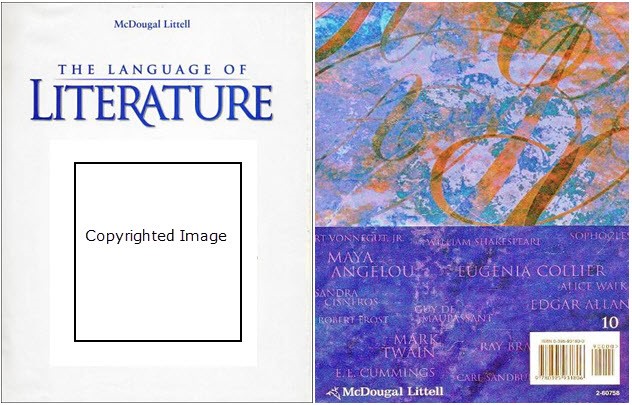
1 ,mc,d\gal ,littell ,,,! language (,'
2 ⠀⠀,lit]ature2 #aj
Sample 2-4: Grade Level Indicated by Dots on Spine

1 ,,macmillan_/,mc,,graw-,,hill ,language
2 ⠀⠀,>ts2 #b
Sample 2-5: Title and Subtitle Including Publisher's Name
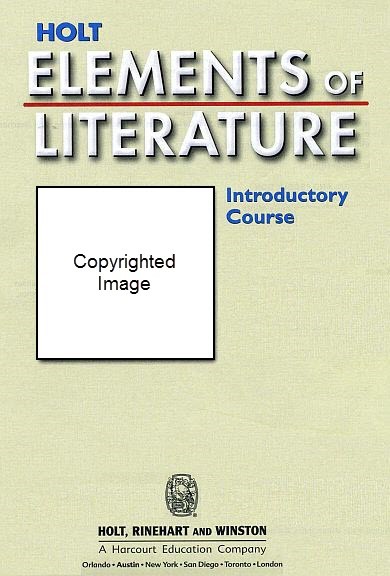
1 ,,,holt ele;ts ( lit]ature,'
2 ,9troductory ,c\rse
Sample 2-6: Title with Edition Number and Subtitle

1 ,we/]n ,civiliza;n2 ,,f\r? ,,$i;n
2 ,compreh5sive ,volume
Sample 2-7: Translator
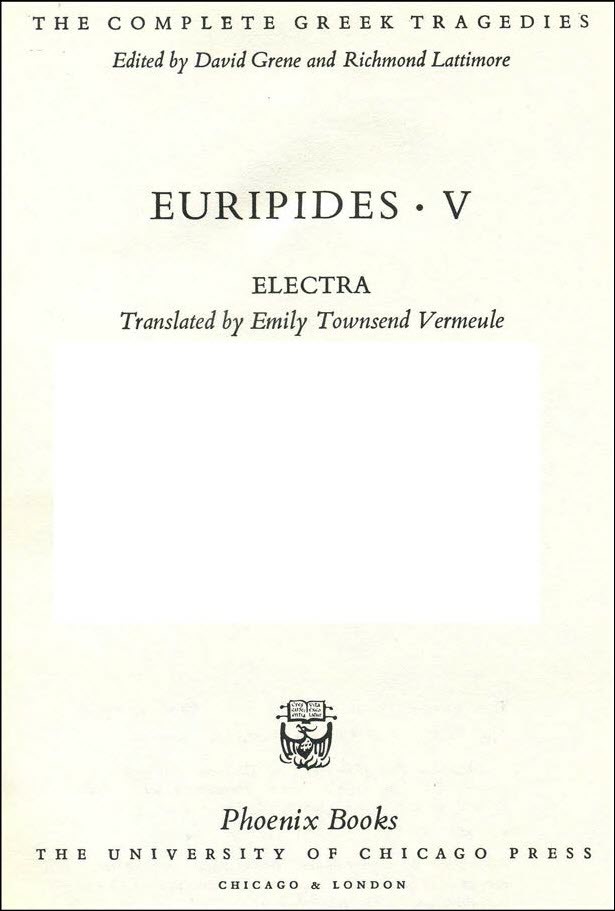
1 ,,electra
2 ,,,! complete greek trag$ies,'
3 ⠀⠀⠀⠀⠀⠀⠀⠀⠀⠀⠀⠀⠀⠀⠀⠀⠀⠀⠀⠀⠀⠀⠀⠀⠀⠀⠀⠀⠀⠀⠀⠀⠀⠀⠀⠀⠀⠀⠀⠀
4 ,,euripides ;,v
5 ,translat$ by ,emily ,t[ns5d ,v]meule
Sample 2-8: Publisher Website

1 ,publi%$ by ,?omson ,c\rse ,te*nology
2 ,bo/on1 ,massa*usetts
3 www4c|rse4com
Sample 2-9: U.S. Title Page
1 ,title2 ,$i;n2 ,grade ,level
2 ,subtitle2 ,s]ies
3 ⠀⠀⠀⠀⠀⠀⠀⠀⠀⠀⠀⠀⠀⠀⠀⠀⠀⠀⠀⠀⠀⠀⠀⠀⠀⠀⠀⠀⠀⠀⠀⠀⠀⠀⠀⠀⠀⠀⠀⠀
4 ,au?or1 ,degrees
5 ⠀⠀⠀⠀⠀⠀⠀⠀⠀⠀⠀⠀⠀⠀⠀⠀⠀⠀⠀⠀⠀⠀⠀⠀⠀⠀⠀⠀⠀⠀⠀⠀⠀⠀⠀⠀⠀⠀⠀⠀
6 ,publi%$ by ,"n ( ,publi%]
7 ,c;y1 ,/ate ( ,publica;n
8 publi%}website4com
9 ,copy"r ,ye> by ,hold] ( ,copy"r
10 ,fur!r reproduc;n or 4tribu;n 9 o!r ?an
11 ⠀⠀a specializ$ =mat is prohibit$4
12 ,transcrip;n ( ,,isbn
13 ,pr9t+ hi/ory3 #i #aj #jga_/#ee #jg #jf
14 ⠀⠀⠀⠀⠀⠀⠀⠀⠀⠀⠀⠀⠀⠀⠀⠀⠀⠀⠀⠀⠀⠀⠀⠀⠀⠀⠀⠀⠀⠀⠀⠀⠀⠀⠀⠀⠀⠀⠀⠀
15 ,transcrib$ ye> 9to ,unifi$ ,5gli% ,brl
16 ⠀⠀by ,"n ( ,transcrib]
17 ,tactile graphics by
18 ⠀⠀,"n ( ,tactile ,graphics ,speciali/
19 ,a6ilia;n ( transcrib]
20 ,c;y1 ,/ate1 ,po/al code a2revia;n
21 ⠀⠀⠀⠀⠀⠀⠀⠀⠀⠀⠀⠀⠀⠀⠀⠀⠀⠀⠀⠀⠀⠀⠀⠀⠀⠀⠀⠀⠀⠀⠀⠀⠀⠀⠀⠀⠀⠀⠀⠀
22 ,9 #,- ,volumes
23 ,volume #,-
24 ,brl pages t#a-t#g1 p#a-p#ad1 & #a-#hj
25 ,pr9t pages i-xx & #a-a#fj t#a
Sample 2-10: Canadian Title Page and Reproduction Notice
1 ⠀⠀⠀⠀⠀⠀⠀⠀⠀⠀,,reluctant ,,g5ius
2 ⠀⠀,! ,pas.nate ,life & ,9v5tive ,m9d (
3 ⠀⠀⠀⠀⠀⠀⠀⠀⠀,alex&] ,graham ,bell
4 ⠀⠀⠀⠀⠀⠀⠀⠀⠀⠀⠀⠀⠀⠀⠀⠀⠀⠀⠀⠀⠀⠀⠀⠀⠀⠀⠀⠀⠀⠀⠀⠀⠀⠀⠀⠀⠀⠀⠀⠀
5 ⠀⠀⠀⠀⠀⠀⠀⠀⠀⠀⠀⠀,,*>lotte ,,gray
6 ⠀⠀⠀⠀⠀⠀⠀⠀⠀⠀⠀⠀⠀⠀⠀⠀⠀⠀⠀⠀⠀⠀⠀⠀⠀⠀⠀⠀⠀⠀⠀⠀⠀⠀⠀⠀⠀⠀⠀⠀
7 ⠀⠀⠀⠀⠀⠀⠀⠀,a ,phyllis ,bruce ,book
8 ⠀⠀⠀⠀⠀⠀⠀⠀⠀⠀⠀⠀⠀⠀,publi%$ by
9 ⠀⠀⠀⠀⠀⠀,h>p],coll9s ,publi%]s ,ltd
10 ⠀⠀⠀⠀⠀⠀⠀⠀⠀⠀⠀,toronto1 ,ont>io
11 ⠀⠀⠀,copy"r ^c #bjjf by ,*>lotte ,gray
12 ⠀⠀⠀⠀⠀⠀⠀⠀⠀⠀⠀⠀⠀⠀⠀⠀⠀⠀⠀⠀⠀⠀⠀⠀⠀⠀⠀⠀⠀⠀⠀⠀⠀⠀⠀⠀⠀⠀⠀⠀
13 ⠀⠀⠀⠀⠀⠀⠀⠀⠀⠀⠀⠀⠀,transcrip;n (
14 ⠀⠀⠀,,isbn #ac3 #igh-#j-#jj-#bjjfgf-#g
15 ⠀⠀⠀⠀⠀,,isbn #aj3 #j-#jj-#bjjfgf-#f
16 ⠀⠀⠀⠀⠀⠀,translat$ #bjaj 9to ,unifi$
17 ⠀⠀⠀⠀⠀⠀⠀⠀⠀⠀⠀,5gli% ,brl by ,"n
18 ⠀⠀⠀⠀⠀,transcrip;n ,complet$ by ,"n
19 ⠀⠀⠀⠀⠀⠀⠀⠀⠀⠀⠀⠀⠀⠀⠀⠀⠀,,cnib
20 ⠀⠀⠀⠀,toronto1 ,ont>io ,m#d,g #c,e#h
21 ⠀⠀⠀⠀⠀⠀⠀⠀⠀⠀⠀⠀⠀⠀⠀⠀⠀⠀⠀⠀⠀⠀⠀⠀⠀⠀⠀⠀⠀⠀⠀⠀⠀⠀⠀⠀⠀⠀⠀⠀
22 ⠀⠀⠀⠀⠀⠀⠀⠀⠀⠀⠀⠀⠀,9 #f ,volumes
23 ⠀⠀⠀⠀⠀⠀⠀⠀⠀⠀⠀⠀⠀⠀⠀,volume #a
24 ⠀⠀,brl pages t#a1 p#a-p#aj1 & #a-#adb
25 ⠀⠀⠀⠀⠀⠀⠀⠀⠀⠀⠀,pr9t pages #a-#ha t#a
—New Braille Page—
1 ⠀⠀,? "w is produc$ = p]sons ) a2 p]ceptual 4abil;y z p] ! ,canadian
3 copy"r act4 ,fur!r 4tribu;n or
4 reproduc;n m/ comply ) ? act4 (Return to Text)
Sample 2-11: Layout of Table of Contents

1 ⠀⠀⠀⠀⠀⠀⠀⠀⠀⠀⠀⠀⠀⠀⠀⠀,,3t5ts vi
2 ⠀⠀⠀⠀⠀⠀⠀⠀⠀⠀⠀⠀⠀⠀⠀⠀⠀⠀⠀⠀⠀⠀⠀⠀⠀⠀⠀⠀⠀⠀⠀⠀⠀⠀⠀⠀⠀⠀⠀⠀
3 ⠀⠀⠀⠀⠀⠀⠀⠀⠀⠀⠀⠀@.<,volume #a@.>
4 ,*apt]
5 ⠀⠀⠀⠀⠀⠀⠀⠀⠀⠀⠀⠀⠀⠀⠀⠀⠀⠀⠀⠀⠀⠀⠀⠀⠀⠀⠀⠀⠀⠀⠀⠀⠀⠀⠀⠀⠀⠀⠀⠀
6 ⠀⠀⠀⠀⠀⠀⠀⠀⠀⠀⠀⠀⠀⠀,unit ,h1d+
7 ⠀⠀⠀⠀⠀⠀⠀⠀⠀⠀⠀⠀⠀⠀⠀,"p ,h1d+ """""""""""" #a
8 #a⠀,*apt]⠀,h1d+⠀""""""""""""""""""""" #b
9 ⠀⠀,sub5try⠀"""""""""""""""""""""""""" #e
10 ⠀⠀,sub5try """"""""""""""""""""""""" #aj
11 ⠀⠀⠀⠀,sub-sub5try """"""""""""""""""" #ab
Sample 2-12: Entire Brief Table of Contents in Volume 1
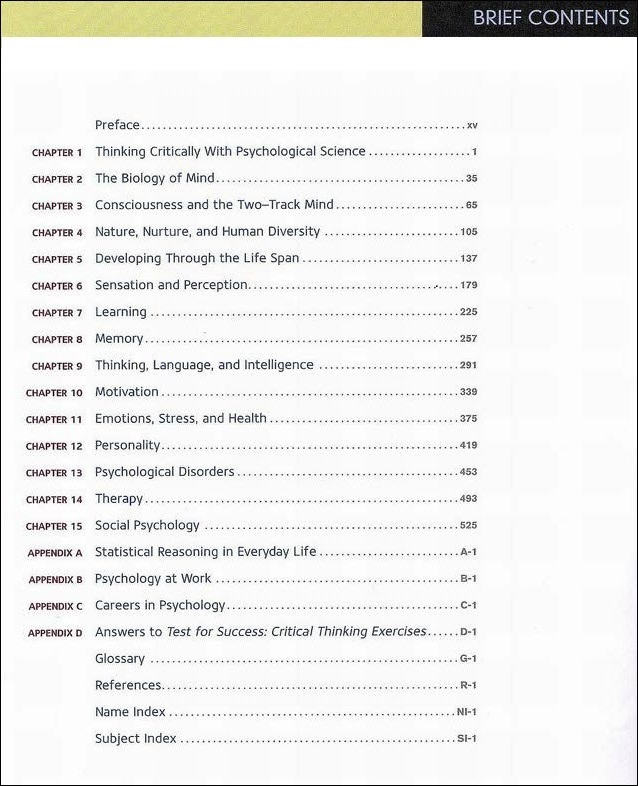

1 ⠀⠀⠀⠀⠀⠀⠀⠀⠀⠀⠀⠀,,brief ,,3t5ts vii
2 ⠀⠀⠀⠀⠀⠀⠀⠀⠀⠀⠀⠀⠀⠀⠀⠀⠀⠀⠀⠀⠀⠀⠀⠀⠀⠀⠀⠀⠀⠀⠀⠀⠀⠀⠀⠀⠀⠀⠀⠀
3 ⠀⠀⠀⠀⠀⠀⠀⠀⠀⠀⠀⠀@.<,volume #a@.>
4 ,preface """""""""""""""""""""""""""" xv
5 ⠀⠀⠀⠀⠀⠀⠀⠀⠀⠀⠀⠀⠀⠀⠀⠀⠀⠀⠀⠀⠀⠀⠀⠀⠀⠀⠀⠀⠀⠀⠀⠀⠀⠀⠀⠀⠀⠀⠀⠀
6 ,,*apt]
7 #a ,?9k+ ,critically ,)
8 ⠀⠀,psy*ological ,sci;e """""""""""""" #a
9 ⠀⠀⠀⠀⠀⠀⠀⠀⠀⠀⠀⠀⠀⠀⠀⠀⠀⠀⠀⠀⠀⠀⠀⠀⠀⠀⠀⠀⠀⠀⠀⠀⠀⠀⠀⠀⠀⠀⠀⠀
10 ⠀⠀⠀⠀⠀⠀⠀⠀⠀⠀⠀⠀@.<,volume #b@.>
11 #b ,! ,biology ( ,m9d """""""""""""" #ce
12 ⠀⠀⠀⠀⠀⠀⠀⠀⠀⠀⠀⠀⠀⠀⠀⠀⠀⠀⠀⠀⠀⠀⠀⠀⠀⠀⠀⠀⠀⠀⠀⠀⠀⠀⠀⠀⠀⠀⠀⠀
13 ⠀⠀⠀⠀⠀⠀⠀⠀⠀⠀⠀⠀@.<,volume #c@.>
14 #c ,3sci\s;s & ! ,two-,track ,m9d "" #fe
15 ⠀⠀⠀⠀⠀⠀⠀⠀⠀⠀⠀⠀⠀⠀⠀⠀⠀⠀⠀⠀⠀⠀⠀⠀⠀⠀⠀⠀⠀⠀⠀⠀⠀⠀⠀⠀⠀⠀⠀⠀
16 ⠀⠀⠀⠀⠀⠀⠀⠀⠀⠀⠀⠀@.<,volume #d@.>
17 #d ,nature1 ,nurture1 & ,human
18 ⠀⠀,div]s;y """""""""""""""""""""""" #aje
19 ⠀⠀⠀⠀⠀⠀⠀⠀⠀⠀⠀⠀⠀⠀⠀⠀⠀⠀⠀⠀⠀⠀⠀⠀⠀⠀⠀⠀⠀⠀⠀⠀⠀⠀⠀⠀⠀⠀⠀⠀
20 ⠀⠀⠀⠀⠀⠀⠀⠀⠀⠀⠀⠀@.<,volume #e@.>
21 #e ,develop+ ,"? ! ,life ,span """" #acg
22 ⠀⠀⠀⠀⠀⠀⠀⠀⠀⠀⠀⠀⠀⠀⠀⠀⠀⠀⠀⠀⠀⠀⠀⠀⠀⠀⠀⠀⠀⠀⠀⠀⠀⠀⠀⠀⠀⠀⠀⠀
Sample 2-13: Single Volume Table of Contents

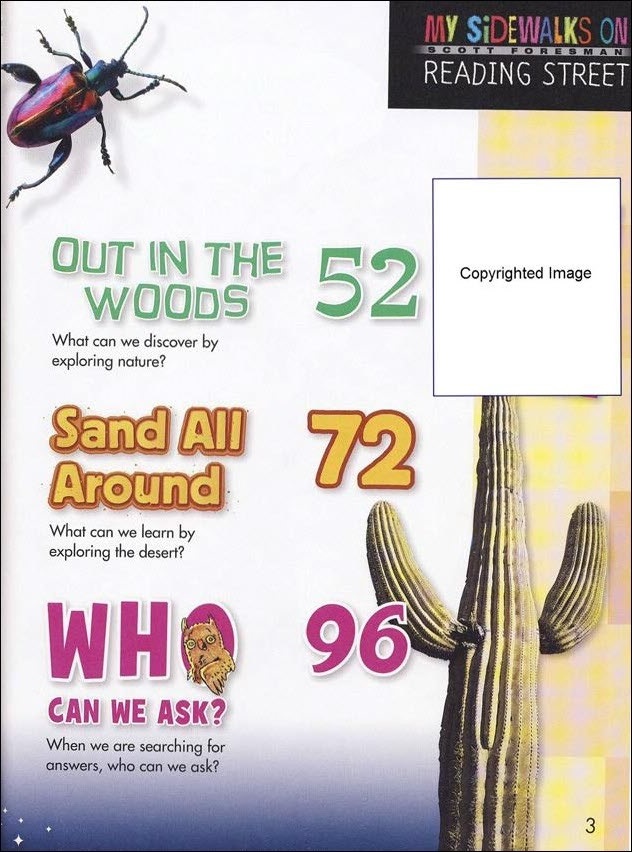
1 ⠀⠀⠀⠀⠀⠀⠀⠀⠀⠀⠀⠀⠀⠀⠀⠀⠀,3t5ts #b
2 ⠀⠀⠀⠀⠀⠀⠀⠀⠀⠀⠀⠀⠀⠀⠀⠀⠀⠀⠀⠀⠀⠀⠀⠀⠀⠀⠀⠀⠀⠀⠀⠀⠀⠀⠀⠀⠀⠀⠀⠀
3 ⠀⠀⠀⠀⠀⠀⠀⠀⠀⠀⠀⠀⠀⠀⠀,explora;n
4 ,nei<borhoods """"""""""""""""""""""" #d
5 ⠀⠀,:at mi<t we 4cov] 9 a new
6 ⠀⠀⠀⠀nei<borhood8
7 ,\t] ,space """""""""""""""""""""""" #bf
8 ⠀⠀,:y wd any"o want to explore
9 ⠀⠀⠀⠀space8
10 --------------------------------------#c
11 ,,,\ 9 ! woods,' """"""""""""""""""" #eb
12 ⠀⠀,:at c we 4cov] by explor+
13 ⠀⠀⠀⠀nature8
14 ,s& ,all ,>.d """""""""""""""""""""" #gb
15 ⠀⠀,:at c we le>n by explor+ !
16 ⠀⠀⠀⠀des]t8
17 ,,,:o c we ask8,' """""""""""""""""" #if
18 ⠀⠀,:5 we >e se>*+ = answ]s1 :o c
19 ⠀⠀⠀⠀we ask8
Sample 2-14: Table of Contents with Numbered Main Entries
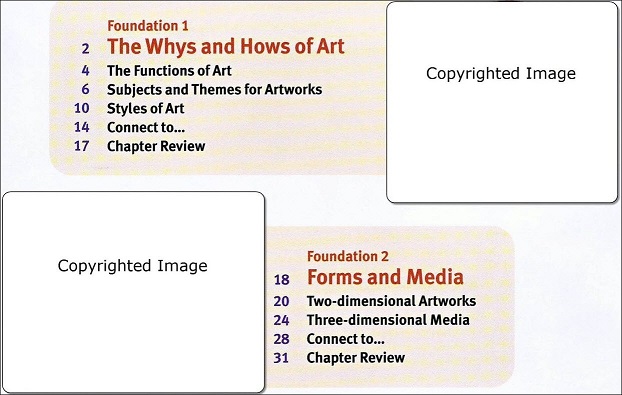
1 ⠀⠀⠀⠀⠀⠀⠀⠀⠀⠀⠀⠀@.<,volume #a@.> iv
2 ,f.da;n
3 #a ,! ,:ys & ,h[s ( ,>t """"""""""""" #b
4 ⠀⠀,! ,func;ns ( ,>t """"""""""""""""" #d
5 ⠀⠀,subjects & ,!mes = ,>t"ws """""""" #f
6 ⠀⠀,/yles ( ,>t """"""""""""""""""""" #aj
7 ⠀⠀,3nect to444 """"""""""""""""""""" #ad
8 ⠀⠀,*apt] ,review """"""""""""""""""" #ag
9 #b ,=ms & ,m$ia """""""""""""""""""" #ah
10 ⠀⠀,two-dim5.nal ,>t"ws """"""""""""" #bj
11 ⠀⠀,?ree-dim5.nal ,m$ia """"""""""""" #bd
12 ⠀⠀,3nect to444 """"""""""""""""""""" #bh
13 ⠀⠀,*apt] ,review """"""""""""""""""" #ca
Sample 2-15: Layout of Multi-Volume Table of Contents
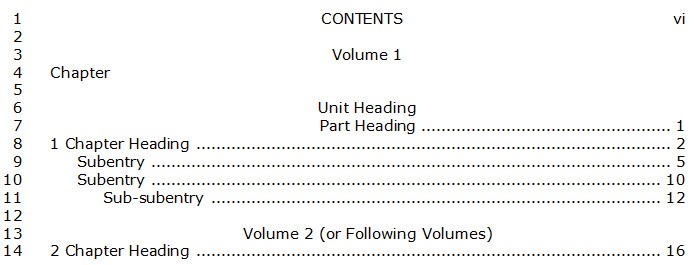
1 ⠀⠀⠀⠀⠀⠀⠀⠀⠀⠀⠀⠀⠀⠀⠀⠀,,3t5ts vi
2 ⠀⠀⠀⠀⠀⠀⠀⠀⠀⠀⠀⠀⠀⠀⠀⠀⠀⠀⠀⠀⠀⠀⠀⠀⠀⠀⠀⠀⠀⠀⠀⠀⠀⠀⠀⠀⠀⠀⠀⠀
3 ⠀⠀⠀⠀⠀⠀⠀⠀⠀⠀⠀⠀@.<,volume #a@.>
4 ,*apt]
5 ⠀⠀⠀⠀⠀⠀⠀⠀⠀⠀⠀⠀⠀⠀⠀⠀⠀⠀⠀⠀⠀⠀⠀⠀⠀⠀⠀⠀⠀⠀⠀⠀⠀⠀⠀⠀⠀⠀⠀⠀
6 ⠀⠀⠀⠀⠀⠀⠀⠀⠀⠀⠀⠀⠀⠀,unit ,h1d+
7 ⠀⠀⠀⠀⠀⠀⠀⠀⠀⠀⠀⠀⠀⠀⠀,"p ,h1d+ """""""""""" #a
8 #a⠀,*apt] ,h1d+⠀""""""""""""""""""""" #b
9 ⠀⠀,sub5try⠀"""""""""""""""""""""""""" #e
10 ⠀⠀,sub5try⠀""""""""""""""""""""""""" #aj
11 ⠀⠀⠀⠀,sub-sub5try """"""""""""""""""" #ab
12 ⠀⠀⠀⠀⠀⠀⠀⠀⠀⠀⠀⠀⠀⠀⠀⠀⠀⠀⠀⠀⠀⠀⠀⠀⠀⠀⠀⠀⠀⠀⠀⠀⠀⠀⠀⠀⠀⠀⠀⠀
13 ⠀⠀⠀⠀⠀⠀⠀⠀⠀⠀⠀⠀@.<,volume #b@.>
14 #b ,*apt] ,h1d+ """""""""""""""""""" #af
Sample 2-16: Table of Contents with Continued Items

1 ⠀⠀⠀⠀⠀⠀⠀⠀⠀⠀⠀⠀⠀⠀⠀⠀⠀,3t5ts vi
2 ⠀⠀⠀⠀⠀⠀⠀⠀⠀⠀⠀⠀⠀⠀⠀⠀⠀⠀⠀⠀⠀⠀⠀⠀⠀⠀⠀⠀⠀⠀⠀⠀⠀⠀⠀⠀⠀⠀⠀⠀
3 ,,*apt]
4 ⠀⠀⠀⠀⠀⠀⠀⠀⠀⠀⠀⠀⠀⠀⠀⠀⠀⠀⠀⠀⠀⠀⠀⠀⠀⠀⠀⠀⠀⠀⠀⠀⠀⠀⠀⠀⠀⠀⠀⠀
5 ⠀⠀⠀⠀⠀⠀⠀⠀⠀⠀⠀⠀⠀⠀⠀,,unit ;,b
6 ⠀⠀⠀⠀⠀⠀⠀⠀⠀⠀⠀⠀,gr[? & ,nutri;n
7 #c ,gr[? & ,develop;t "<3t4">
8 ⠀⠀,,lesson #e ,ag+ 9 a ,h1l?;l
9 ⠀⠀⠀⠀⠀⠀,way """"""""""""""""""""""" ,b#cd
10 ⠀⠀⠀⠀,,,life skills activ;y3,'
11 ⠀⠀⠀⠀⠀⠀,practice ,h1l?;l⠀,2haviors1 ,b#cg
12 ⠀⠀⠀⠀,,l9k3 ,sci;e1 """"""""""""""" ,b#ch
13 ⠀⠀⠀⠀,,,make a di6];e3,' ,dazzl+
14 ⠀⠀⠀⠀⠀⠀,de$1 """""""""""""""""""""" ,b#ci
16 ⠀⠀,,*apt] #c ,,review """""""""""" ,b#dj
(Return to Text)
Sample 2-17: Dots Separating Linear Contents Entries

6 ,writ+ ,ab ,lit]ature
7 ⠀⠀#c4e ,analyz+ ,"* ,descrip;ns """ #aef
8 ⠀⠀⠀⠀,write a ,"* ,analysis2 ,us+
9 ⠀⠀⠀⠀⠀⠀⠀⠀,comput]s2 ,view+ &
10 ⠀⠀⠀⠀⠀⠀⠀⠀,repres5t+2 `#1,gramm>
11 ⠀⠀⠀⠀⠀⠀⠀⠀`#1,l9k
12 ,writ+ ,process 9 ,ac;n
13 ⠀⠀,descriptive ,writ+ ,project """" #afj
14 ⠀⠀⠀⠀,write ab an imag9$ place4
15 ⠀⠀⠀⠀⠀⠀,prewrit+
16 ⠀⠀⠀⠀⠀⠀,draft+
17 ⠀⠀⠀⠀⠀⠀,revis+
18 ⠀⠀⠀⠀⠀⠀,$it+_/,pro(r1d+
19 ⠀⠀⠀⠀⠀⠀,publi%+_/,pres5t+

8 #a ,,^ws ,,) sk1 sp1 st """""""""""" #ad
9 ⠀⠀^7,?9k & ,practice^' ,m1n+
10 ⠀⠀⠀⠀,clues1 ,hidd5 ,^ws
11 ⠀⠀^1,/rategic ^1,spell+ ,us+ !
12 ⠀⠀⠀⠀,problem ,"ps ,/rategy
13 ⠀⠀^7,pro(r1d+ & ,writ+^' ,an
14 ⠀⠀⠀⠀,op9ion
15 ⠀⠀^1,vocabul>y ^1,build+ ,review3
16 ⠀⠀⠀⠀,cross^w ,puzzle1 ,^w ,/udy3
17 ⠀⠀⠀⠀,similes
18 #b ,,^ws ,,) ng1 nk1 th """""""""""" #ah
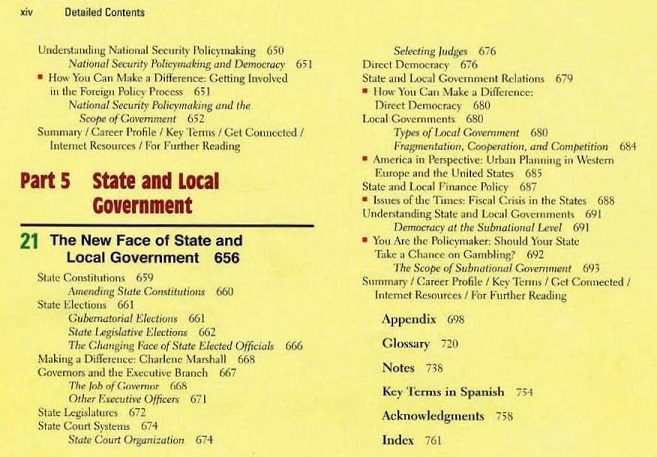
1 ⠀⠀⠀⠀⠀⠀⠀⠀⠀⠀⠀⠀,detail$ ,3t5ts xiv
2 ⠀⠀⠀⠀⠀⠀⠀⠀⠀⠀⠀⠀⠀⠀⠀⠀⠀⠀⠀⠀⠀⠀⠀⠀⠀⠀⠀⠀⠀⠀⠀⠀⠀⠀⠀⠀⠀⠀⠀⠀
3 ⠀⠀⠀⠀⠀⠀⠀⠀⠀⠀⠀⠀⠀⠀⠀⠀⠀,"p #e
4 ⠀⠀⠀⠀⠀⠀⠀⠀,/ate & ,local ,gov]n;t
5 #ba ,! ,new ,face ( ,/ate & ,local
6 ⠀⠀⠀⠀⠀⠀,gov]n;t """""""""""""""""""" #fef
7 ⠀⠀,/ate ,3/itu;ns """"""""""""""""" #fei
8 ⠀⠀⠀⠀,am5d+ ,/ate ,3/itu;ns """""""" #ffj
9 ⠀⠀,/ate ,elec;ns """""""""""""""""" #ffa
10 ⠀⠀⠀⠀,gub]natorial ,elec;ns """""""" #ffa
11 ⠀⠀⠀⠀,/ate ,legislative ,elec;ns """ #ffb
12 ⠀⠀⠀⠀,! ,*ang+ ,face ( ,/ate
13 ⠀⠀⠀⠀⠀⠀,elect$ ,(ficials """"""""""" #fff
14 ⠀⠀,mak+ a ,di6];e3 ,*>l5e ,m>%all #ffh
15 444
16 ⠀⠀,"u/&+ ,/ate & ,local ,gov]n;ts #fia
17 ⠀⠀⠀⠀,democracy at ! ,subna;nal
18 ⠀⠀⠀⠀⠀⠀,level """""""""""""""""""""" #fia
19 ⠀⠀_4 ,y ,>e ! ,policymak]3 ,%d ,yr
20 ⠀⠀⠀⠀⠀⠀,/ate ,take a ,*.e on
21 ⠀⠀⠀⠀⠀⠀,gambl+8 """""""""""""""""""" #fib
22 ⠀⠀⠀⠀⠀⠀⠀⠀⠀⠀⠀⠀⠀⠀⠀⠀⠀⠀⠀⠀⠀⠀⠀⠀⠀⠀⠀⠀⠀⠀⠀⠀⠀⠀⠀⠀⠀⠀⠀⠀
23 ,notes """""""""""""""""""""""""""" #gch
24 ,key ,t]ms 9 ,spani% """""""""""""" #ged
25 ⠀⠀⠀⠀⠀⠀⠀⠀⠀⠀⠀⠀⠀⠀⠀⠀⠀⠀⠀⠀⠀⠀⠀⠀⠀⠀⠀⠀⠀⠀⠀⠀⠀⠀⠀⠀⠀p#b
Sample 2-20: Categorized Table of Contents

1 ⠀⠀⠀⠀⠀⠀⠀⠀⠀,/ud5t ,res\rce ,bank⠀⠀⠀⠀⠀⠀⠀xiv
2 ⠀⠀⠀⠀⠀⠀⠀⠀⠀⠀⠀⠀⠀⠀⠀⠀⠀⠀⠀⠀⠀⠀⠀⠀⠀⠀⠀⠀⠀⠀⠀⠀⠀⠀⠀⠀⠀⠀⠀⠀
3 ⠀⠀⠀⠀,issues & ,viewpo9ts
4 ,! ,future ( ,ra9 ,=e/s """"""""""" #bbh
5 ,! ,public ,sp1ks ,\ """""""""""""" #ehh
6 ⠀⠀⠀⠀⠀⠀⠀⠀⠀⠀⠀⠀⠀⠀⠀⠀⠀⠀⠀⠀⠀⠀⠀⠀⠀⠀⠀⠀⠀⠀⠀⠀⠀⠀⠀⠀⠀⠀⠀⠀
7 ⠀⠀⠀⠀,!n & ,n[
8 ,new ,crop ,develop;t """""""""""""" #bj
9 ,h>appa & ,sahiwal1 ,paki/an3 ,l&
10 ⠀⠀( ,cotton """"""""""""""""""""""" #abf
11 ,! ,9uit """""""""""""""""""""""""" #bbc
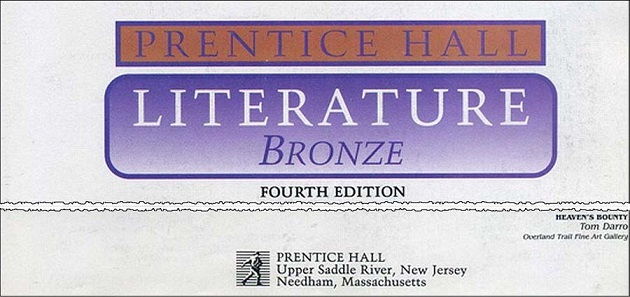

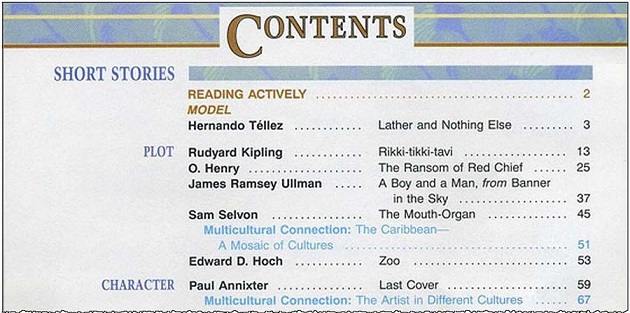
Title Page Volume 1
1 ,,,pr5tice hall lit]ature3,' ,bronze
2 ,,f\r? ,,$i;n
3 ⠀⠀⠀⠀⠀⠀⠀⠀⠀⠀⠀⠀⠀⠀⠀⠀⠀⠀⠀⠀⠀⠀⠀⠀⠀⠀⠀⠀⠀⠀⠀⠀⠀⠀⠀⠀⠀⠀⠀⠀
4 ⠀⠀⠀⠀⠀⠀⠀⠀⠀⠀⠀⠀⠀⠀⠀⠀⠀⠀⠀⠀⠀⠀⠀⠀⠀⠀⠀⠀⠀⠀⠀⠀⠀⠀⠀⠀⠀⠀⠀⠀
5 ⠀⠀⠀⠀⠀⠀⠀⠀⠀⠀⠀⠀⠀⠀⠀⠀⠀⠀⠀⠀⠀⠀⠀⠀⠀⠀⠀⠀⠀⠀⠀⠀⠀⠀⠀⠀⠀⠀⠀⠀
6 ,publi%$ by ,pr5tice ,hall
7 ,upp] ,saddle ,riv]1 ,new ,j]sey
8 ,copy"r ^c #aiif by ,pr5tice-,hall1 ,9c4
9 ,fur!r reproduc;n or 4tribu;n 9 o!r ?an
10 ⠀⠀a specializ$ =mat is prohibit$4
11 ,transcrip;n ( ,,isbn #j-#ac-#hchbaj-#g
12 ,pr9t+ hi/ory3 #a #b #c #d #e #f #g #h
13 ⠀⠀#i #aj #ii #ih #ig #if #ie
14 ⠀⠀⠀⠀⠀⠀⠀⠀⠀⠀⠀⠀⠀⠀⠀⠀⠀⠀⠀⠀⠀⠀⠀⠀⠀⠀⠀⠀⠀⠀⠀⠀⠀⠀⠀⠀⠀⠀⠀⠀
15 ⠀⠀⠀⠀⠀⠀⠀⠀⠀⠀⠀⠀⠀⠀⠀⠀⠀⠀⠀⠀⠀⠀⠀⠀⠀⠀⠀⠀⠀⠀⠀⠀⠀⠀⠀⠀⠀⠀⠀⠀
16 ,transcrib$ #bjaj 9to ,unifi$ ,5gli%
17 ⠀⠀,brl by ,transcrib]
18 ,a6ilia;n
19 ,loca;n
20 ⠀⠀⠀⠀⠀⠀⠀⠀⠀⠀⠀⠀⠀⠀⠀⠀⠀⠀⠀⠀⠀⠀⠀⠀⠀⠀⠀⠀⠀⠀⠀⠀⠀⠀⠀⠀⠀⠀⠀⠀
21 ⠀⠀⠀⠀⠀⠀⠀⠀⠀⠀⠀⠀⠀⠀⠀⠀⠀⠀⠀⠀⠀⠀⠀⠀⠀⠀⠀⠀⠀⠀⠀⠀⠀⠀⠀⠀⠀⠀⠀⠀
22 ,9 #bf ,volumes
23 ,volume #a
24 ,brl pages t#a-t#d1 p#a-p#bi1 & #a-#aaf
25 ,pr9t pages i-;x1 #a-#dd1 & #ghb t#a
Special Symbols
1 ⠀⠀⠀⠀⠀⠀⠀⠀⠀⠀⠀,,,special symbols
2 ⠀⠀⠀⠀⠀⠀⠀⠀⠀⠀⠀⠀us$ 9 ? volume,'
3 ⠀⠀⠀⠀⠀⠀⠀⠀⠀⠀⠀⠀⠀⠀⠀⠀⠀⠀⠀⠀⠀⠀⠀⠀⠀⠀⠀⠀⠀⠀⠀⠀⠀⠀⠀⠀⠀⠀⠀⠀
4 .= ,dot locator2 prec$es li/$ symbols
5 .=^1 ,boldface ^w 9dicator
6 .=^7 ,boldface passage 9dicator
7 .=^/ ,acute a35t abv lr
8 .=^' ,boldface t}m9ator
9 444
25 ⠀⠀⠀⠀⠀⠀⠀⠀⠀⠀⠀⠀⠀⠀⠀⠀⠀⠀⠀⠀⠀⠀⠀⠀⠀⠀⠀⠀⠀⠀⠀⠀⠀⠀⠀⠀⠀t#b
Transcriber's Notes
1 ⠀⠀⠀⠀⠀⠀⠀⠀,,transcrib]',s ,,notes
2 ⠀⠀⠀⠀⠀⠀⠀⠀⠀⠀⠀⠀⠀⠀⠀⠀⠀⠀⠀⠀⠀⠀⠀⠀⠀⠀⠀⠀⠀⠀⠀⠀⠀⠀⠀⠀⠀⠀⠀⠀
3 ⠀⠀,! atlas is omitt$4
4 ⠀⠀,a s]ies ( ?ree guide dots 9dicates a
5 blank space 9 pr9t4
6 ⠀⠀,9 a table1 a s]ies ( dot #es acr !
7 wid? ( a column 9dicates a blank space 9
8 pr9t4
9 ⠀⠀444
25 ⠀⠀⠀⠀⠀⠀⠀⠀⠀⠀⠀⠀⠀⠀⠀⠀⠀⠀⠀⠀⠀⠀⠀⠀⠀⠀⠀⠀⠀⠀⠀⠀⠀⠀⠀⠀⠀t#c
Table of Contents, Volume 1
1 ⠀⠀⠀⠀⠀⠀⠀⠀⠀⠀⠀⠀⠀⠀⠀⠀,,3t5ts ;v
2 ⠀⠀⠀⠀⠀⠀⠀⠀⠀⠀⠀⠀⠀⠀⠀⠀⠀⠀⠀⠀⠀⠀⠀⠀⠀⠀⠀⠀⠀⠀⠀⠀⠀⠀⠀⠀⠀⠀⠀⠀
3 ⠀⠀⠀⠀⠀⠀⠀⠀⠀⠀⠀⠀@.<,volume #a@.>
4 ⠀⠀⠀⠀⠀⠀⠀⠀⠀⠀⠀⠀,,%ort ,,/ories
5 ,,,r1d+ actively .1model,' """""""""" #b
6 ^1,h]n&o ^1,t^/ellez ,la!r & ,no?+
7 ⠀⠀⠀⠀,else """"""""""""""""""""""""""" #c
8 ⠀⠀⠀⠀⠀⠀⠀⠀⠀⠀⠀⠀⠀⠀⠀⠀⠀⠀⠀⠀⠀⠀⠀⠀⠀⠀⠀⠀⠀⠀⠀⠀⠀⠀⠀⠀⠀⠀⠀⠀
9 ⠀⠀⠀⠀,,plot
10 ^1,rudy>d ^1,kipl+ ,rikki-tikki-tavi #ac
11 ^1,o4 ^1,h5ry ,! ,ransom ( ,r$ ,*ief #be
12 ^7,james ,ramsey ,ullman^' ,a ,boy
13 ⠀⠀⠀⠀& a ,man1 .1f ,bann] 9 ! ,sky "" #cg
14 ⠀⠀⠀⠀⠀⠀⠀⠀⠀⠀⠀⠀⠀⠀⠀⠀⠀⠀⠀⠀⠀⠀⠀⠀⠀⠀⠀⠀⠀⠀⠀⠀⠀⠀⠀⠀⠀⠀⠀⠀
15 ⠀⠀⠀⠀⠀⠀⠀⠀⠀@.<,foll[+ ,volumes@.>
16 ^1,sam ^1,selvon ,! ,m\?-,organ """" #de
17 ⠀⠀^1,multicultural ^1,3nec;n3 ,!
18 ⠀⠀⠀⠀,c>i21n,-,a ,mosaic ( ,cultures #ea
19 ^7,$w>d ;,d4 ,ho*^' ,zoo """"""""""" #ec
20 ⠀⠀⠀⠀⠀⠀⠀⠀⠀⠀⠀⠀⠀⠀⠀⠀⠀⠀⠀⠀⠀⠀⠀⠀⠀⠀⠀⠀⠀⠀⠀⠀⠀⠀⠀⠀⠀⠀⠀⠀
21 ⠀⠀⠀⠀,,"*
22 ^1,paul ^1,annixt] ,la/ ,cov] """""" #ei
23 ⠀⠀^1,multicultural ^1,3nec;n3 ,!
24 ⠀⠀⠀⠀,>ti/ 9 ,di6]5t ,cultures """""" #fg
25 ⠀⠀⠀⠀⠀⠀⠀⠀⠀⠀⠀⠀⠀⠀⠀⠀⠀⠀⠀⠀⠀⠀⠀⠀⠀⠀⠀⠀⠀⠀⠀⠀⠀⠀⠀⠀⠀p#a
Table of Contents, Volume 2
1 ⠀⠀⠀⠀⠀⠀⠀⠀⠀⠀⠀⠀⠀⠀⠀⠀,,3t5ts ;v
2 ⠀⠀⠀⠀⠀⠀⠀⠀⠀⠀⠀⠀⠀⠀⠀⠀⠀⠀⠀⠀⠀⠀⠀⠀⠀⠀⠀⠀⠀⠀⠀⠀⠀⠀⠀⠀⠀⠀⠀⠀
3 ⠀⠀⠀⠀⠀⠀⠀⠀⠀⠀⠀⠀,,%ort ,,/ories
4 ⠀⠀⠀⠀⠀⠀⠀⠀⠀⠀⠀⠀⠀⠀⠀⠀⠀⠀⠀⠀⠀⠀⠀⠀⠀⠀⠀⠀⠀⠀⠀⠀⠀⠀⠀⠀⠀⠀⠀⠀
5 ⠀⠀⠀⠀,,plot "<3t4">
6 ^1,sam ^1,selvon ,! ,m\?-,organ """" #de
7 ⠀⠀^1,multicultural ^1,3nec;n3 ,!
8 ⠀⠀⠀⠀,c>i21n,-,a ,mosaic ( ,cultures #ea
9 ^7,$w>d ;,d4 ,ho*^' ,zoo """"""""""" #ec
10 ⠀⠀⠀⠀⠀⠀⠀⠀⠀⠀⠀⠀⠀⠀⠀⠀⠀⠀⠀⠀⠀⠀⠀⠀⠀⠀⠀⠀⠀⠀⠀⠀⠀⠀⠀⠀⠀⠀⠀⠀
11 ⠀⠀⠀⠀,,"*
12 ^1,paul ^1,annixt] ,la/ ,cov] """""" #ei
13 ⠀⠀^1,multicultural ^1,3nec;n3 ,!
14 ⠀⠀⠀⠀,>ti/ 9 ,di6]5t ,cultures """""" #fg
Pronunciation Key in Front Matter Pages
1 ⠀⠀⠀⠀⠀⠀⠀⠀⠀⠀⠀,pronuncia;n ,key #ghb
2 ⠀⠀⠀⠀⠀⠀⠀⠀⠀⠀⠀⠀⠀⠀⠀⠀⠀⠀⠀⠀⠀⠀⠀⠀⠀⠀⠀⠀⠀⠀⠀⠀⠀⠀⠀⠀⠀⠀⠀⠀
3 a ^2asp1 f^2at1 p^2>rot
4 `-a ^2ape1 d^2ate1 pl^2ay
5 ^3a ^2ah1 c^2>1 f^2a!r
6 ;e ^2elf1 t^251 b^2}ry
7 `-e ^2ev51 m^1ee^'t1 mon^2ey
8 444
25 ⠀⠀⠀⠀⠀⠀⠀⠀⠀⠀⠀⠀⠀⠀⠀⠀⠀⠀⠀⠀⠀⠀⠀⠀⠀⠀⠀⠀⠀⠀⠀⠀⠀⠀⠀⠀p#bi
(Return to Text)
